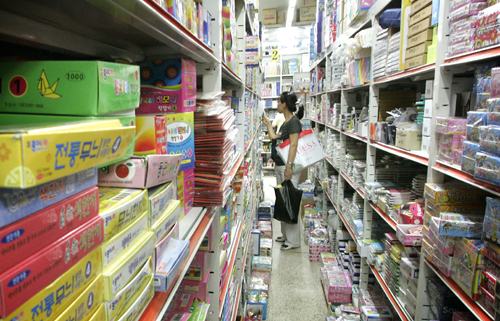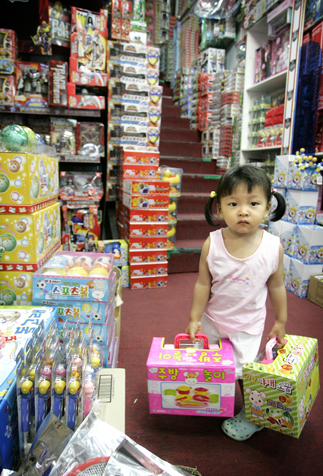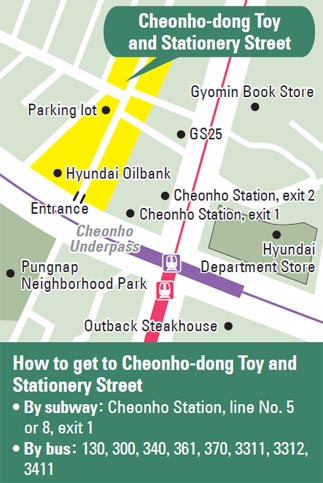Stationery and Toy St. attracts young and old

A customer at Jangan Stationery store shops for some school supplies at the Cheonho-dong Stationery and Toy Street in eastern Seoul. The store is usually more packed with parents buying notebooks and pencils for their children in the month before school starts. By Oh Sang-min
It’s true that the economic downturn has left the 24-year-old commercial street less packed than usual, but the street is still vibrant with toddlers nagging their parents to buy them their favorite toys, which, today, seem to feature the little blue penguin called Pororo. There are also wholesalers picking out a few of the countless types of stationery and toys on display.
“You just can’t imagine how many different kinds of products there are here compared to other stores in different areas,” said Jung Jun, a wholesaler from Jeju Island.
On a recent afternoon, Jung was on his regular visit to Myungsin Toy, one of the oldest stores founded 17 years ago on the commercial street.
“I come here once every two months to buy different toy products to bring back home to the store I own on Jeju,” he said, while turning his eyes to a shelf filled with water guns. He said water guns sell out the fastest during summer vacation season.
Whenever he visits, Jung said he spends up to 3 million won ($2,400) on purchasing new toys. So, why does he fly all the way from the remote island to the street in eastern Seoul? What business benefits does he get?
“Here, I can find toys that are hard to find elsewhere, so that distinguishes my store from others. Plus, it’s cheaper,” he said.

A young child clutches two toys - a kitchen set in her right hand and a vegetable cooking set in her left - at Myungsin Toy, one of the stores on the Cheonho-dong Stationery and Toy Street in eastern Seoul. By Oh Sang-min
“The products here are 30 to 40 percent cheaper compared to the market consumer price because we reduce margin costs. Everything here is bought directly from the manufacturers,” Cho said. He added that many of the wholesalers are from the eastern Gyeonggi area including Icheon and Yeoju, and also from parts of Gangwon Province.
Out on the street was a foreign English teacher from a hagwon (private teaching institute) in Bundang who drove more than half an hour to buy some stationery goods for her students. She said the drive was worth it.
“I bought a bundle of crayons and notebooks for a discounted price,” said the teacher, who declined to be named. “Buying paper here saves me a considerable amount of money compared to buying it at a large discount store or nearby neighborhood shops.”
For instance, the consumer price of an imported pen from Japan would elsewhere cost 3,000 won, but at Cheonho-dong it’s 2,000 won. The only inconvenience is that consumers have to buy products in large lots since products are sold wholesale.
Purchasing such products in large quantities is not an option for many parents, though. So at the start of school semesters, groups of economical parents come here and jointly purchase school supplies for their children.
Parents also come here to buy toys on holidays like Halloween and Christmas. Though the Toy Street in Changsin-dong [JoongAng Daily, Sept. 29, 2008 issue] near the Dongdaemun subway station in central Seoul is bigger with more stores, the Cheonho-dong street is beginning to build a large customer base.
In fact, it was several store owners from Changsin-dong who moved to Cheonho-dong in 1985 to create a new commercial area in eastern Seoul. The street in central Seoul became too competitive as more stores opened up in the limited area, according to Oh Joo-hwan, one of the first store owners on the street. He owns Fancy Land and is also the head of the Cheonho-dong Stationery and Toy Street Association.
During its first year, there were only three toy stores, according to Oh. Business in the area gradually expanded to more than 50 stationery and toy stores clustered along the 100-meter long alley. There are also stores specializing in art materials and papers.
Ten years ago, the area had a cross-country bus terminal connecting the Gyeonggi and Gangwon areas so many regional stationery retailers visited the stores in Cheonho-dong. Though the terminal doesn’t exist anymore, both retailers and wholesalers stop by from the outskirts of Seoul, including Seongnam and Yongin, Oh says.
“But compared to back then when business was fairly independent and dominant in the area, business today is quite difficult as retail giants opening nearby are snatching up our customers,” Oh said.
“The consumer pattern has changed dramatically over the years,” he said. “Consumers today have more purchasing tools, including the Internet and discount marts. In the past, most of the people either bought their toys at Changsin-dong or neighborhood stationery stores.”
Until now, wholesalers have been informally obliged to offer limited discount prices, maybe up to 60 percent, to protect small retailers.
“But the reality is that, with large discount stores opening near the privately owned retail stores, up to 10 percent of the stores a year have no choice but to close down,” he said. Because of the bad economy and also the emerging discount stores, overall sales decreased 40 percent in 2009 on-year.
Though stores here offer products up to 20 percent cheaper than large discount stores, an increasing number of families prefer shopping at discount stores because they are more convenient. There are bigger parking lots and consumers can shop for different items, such as groceries or clothing.
“What we can offer that discount stores cannot is a variety of [toy and stationery] products,” Oh said. “Large discount stores tend to take away products from the shelves when they don’t make much profit. But here, we provide an assortment of products.”
In a side effort to promote the street, the Gangdong District Office designated the Cheonho-dong Stationery and Toy Street as a special zone in 2001. And it recently changed the signboards of stores including the entrance arch.

“Since parking is always a problem for traditional markets or commercial streets, we started providing an hour of free parking to customers who purchase more than 50,000 won in products,” said Cho Mi-ran from the Gangdong District Office.
By Lee Eun-joo [angie@joongang.co.kr]










with the Korea JoongAng Daily
To write comments, please log in to one of the accounts.
Standards Board Policy (0/250자)